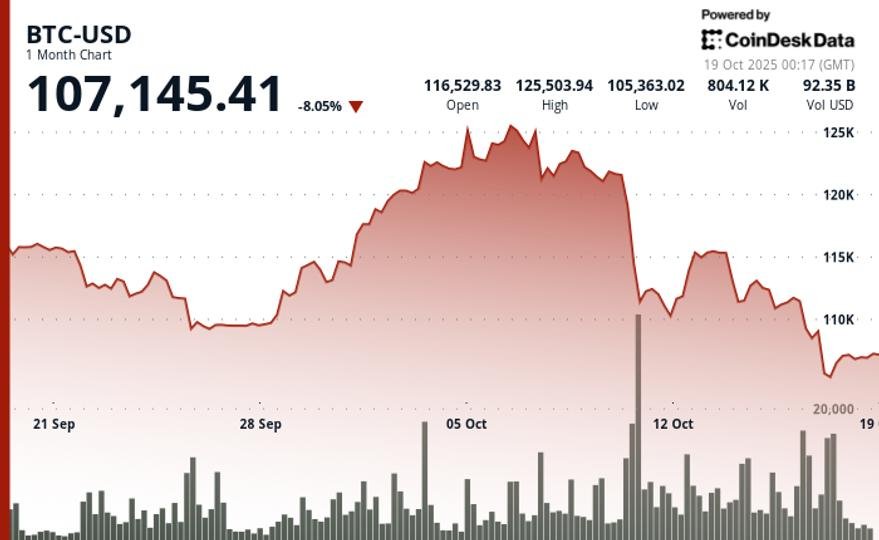Understanding Bitcoin’s Resilience Amid October Sell-Off: Insights from Galaxy Digital
The recent turbulence in the cryptocurrency market, particularly the significant sell-off on October 10, has spurred a wave of speculative dialogues concerning Bitcoin and broader digital assets. Alex Thorn, the head of research at Galaxy Digital, emphasizes that this seasonal "wobble" has not disrupted the ongoing bullish cycle for cryptocurrencies. In his analysis shared with Galaxy Research subscribers and later disseminated via X, he outlines the mechanisms behind the recent price fluctuations and discusses the medium-term prospects for Bitcoin and other major cryptocurrencies.
The October sell-off, which saw Bitcoin plummet from an all-time high of approximately $126,300 on October 6 to an intraday low of roughly $107,000, was primarily driven by high leverage impacting thin order books. As Thorn details, this selling pressure escalated due to auto-deleveraging mechanisms that curtailed some market-maker shorts, severely thinning liquidity at the critical moment. Approximately $19 billion in liquidations were recorded, not only for Bitcoin but also for Ethereum, which faced a decline from around $4,800 to about $3,500.
Market sentiments shifted further into the "risk-off" territory with renewed macroeconomic concerns. Thorn identifies this shift as influenced by a downturn in technology stocks, a hawkish stance from the Federal Reserve, emerging worries about regional banks, and geopolitical tensions. Traditional indicators such as gold and silver hitting new highs, alongside the 10-year Treasury yield dropping below 4%, underscored the broader risk-averse climate. In particular, the cooling interest from digital asset treasury firms added to the fragility of the crypto landscape, as diminished equity values limited price-insensitive purchases into digital assets.
However, Thorn emphasizes optimism moving forward, identifying three key catalysts poised to propel Bitcoin and the broader cryptocurrency market in the medium term. The first driver is the surge in artificial intelligence (AI) capital expenditure, which he frames as a sustainable real-economy investment wave. This cycle, led by capital-rich technological incumbents such as hyperscalers, chipmakers, and data-center operators, benefits from supportive U.S. policy – a stark contrast to the speculative nature of the dot-com bubble.
The second pivotal factor identified by Thorn is the rising utility of stablecoins, which have solidified their role as essential payment mechanisms. He asserts that the growing adoption of dollar-linked stablecoins enhances market participation, increases liquidity, and anchors activities within public blockchain ecosystems. These foundational benefits are crucial for sustaining the cryptocurrency scene, especially during times of erratic price movements.
Thirdly, Thorn points to the trend of tokenization, where real-world assets and traditional market infrastructures are progressively being integrated onto blockchain platforms. This transition from pilot phases to actual implementation not only creates a fresh demand for blockchain space but also augments the underlying value of cryptocurrencies that facilitate, secure, and settle these transactions.
Throughout this ongoing transformation, Thorn remains confident in Bitcoin’s status as "digital gold," especially in light of ongoing concerns about fiscal and monetary stability. He highlights an encouraging setup for major cryptocurrencies such as Ethereum (ETH) and Solana (SOL) due to their integration with stablecoin usage and tokenization processes. Nonetheless, he notes the necessity for caution in the near term, advising stakeholders to remain aware of thinner liquidity and the psychological aftermath of market crashes, which often foster a "wall of worry" among investors.
In summation, while the October sell-off may have challenged market sentiments and ignited fears of a bearish reversal, the analysis by Alex Thorn provides a balanced perspective. With robust medium-term drivers underpinning the future of Bitcoin and major cryptocurrencies, investors may find resilience in the face of volatility. Understanding these dynamics will be crucial as the cryptocurrency market continues to navigate the complexities of global economic shifts.

















